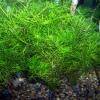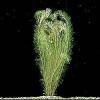Rotala indica
Scientific name: Rotala indica
Family: Lythraceae
Usual maximum size in aquariums: 40 - 60 cm (15.75 - 23.62 inch)
014
Recommended pH range for the species: 5.8 - 7.1
Recommended water hardness (dGH): 4 - 12°N (71.43 - 214.29ppm)
0°C 32°F30°C 86°F
Recommended temperature: 22 - 26 °C (71.6 - 78.8°F)
Reproduction of the plant: Cuttings
Origin (in the wild): East Asia
How fast these plants grow: Fast
Recommended substrate: Fine gravel
Demands on lighting: Bright
Ideal placement in a fish tank: Background
Common Name
Indian Toothcup
Origin
Rotala indica is native to tropical Asia, particularly India, Sri Lanka, and Bangladesh. It thrives in wet, marshy areas and rice paddies, often growing emersed in the wild and submerged in aquariums.
Propagation
This plant propagates easily via cuttings. When trimming the mother plant, save healthy stem tips and remove the bottom few leaves to expose a short section of bare stem. Insert this section into the substrate gently to avoid damage. Under stable conditions, roots will form at the first node and the cutting will quickly establish itself.
Difficulty
Medium
Short Description
Rotala indica is a fast-growing, vibrant stem plant ideal for the background of freshwater aquariums. It has slender leaves that are green on top and pinkish underneath, creating an attractive contrast. With sufficient light and nutrients, the coloration can intensify and the plant forms bushy clusters. It benefits greatly from CO2 supplementation and regular dosing of trace elements.
This species is relatively easy to care for but has fragile stems that can be damaged by rough handling or overly active fish. Regular pruning encourages bushier growth and helps maintain an open aquascape. It's often mistaken for Rotala rotundifolia, but R. indica has a more upright and orderly growth pattern with smaller, denser leaves.
FAQs
-
What’s the difference between Rotala indica and Rotala rotundifolia?
Although often confused, Rotala indica has more upright, compact growth and smaller, more densely spaced leaves. R. rotundifolia tends to have slightly rounder leaves and a trailing or bushier growth habit. Proper identification helps with layout planning in aquascaping.
-
Can Rotala indica grow emersed?
Yes, in the wild it often grows emersed in rice paddies and wet fields. In aquarium settings, it adapts well to submerged conditions, especially with high lighting and nutrient support.
-
How do I maintain its pink coloration?
To achieve and maintain the pink underside of the leaves, provide bright lighting (preferably full spectrum), stable CO2 levels, and a nutrient-rich water column—particularly with adequate iron and trace elements.
-
How often should I trim Rotala indica?
Trim regularly to encourage lateral shoots and denser, bushier growth. Prune the top portions when the plant reaches the water surface or becomes leggy, and replant healthy tips to maintain shape and coverage.
-
Is Rotala indica suitable for beginners?
It's considered moderately easy, but beginners should be aware that without sufficient light and nutrients, the plant may grow slowly or become leggy. With proper care, it is a very rewarding species for aquascaping.

 Ammania gracilis
Ammania gracilis Ammania senegalensis
Ammania senegalensis Didiplis diandra
Didiplis diandra Nesaea crassicaulis
Nesaea crassicaulis Rotala macrandra
Rotala macrandra Rotala nanjenshan
Rotala nanjenshan Rotala rotundifolia
Rotala rotundifolia Rotala wallichii
Rotala wallichii